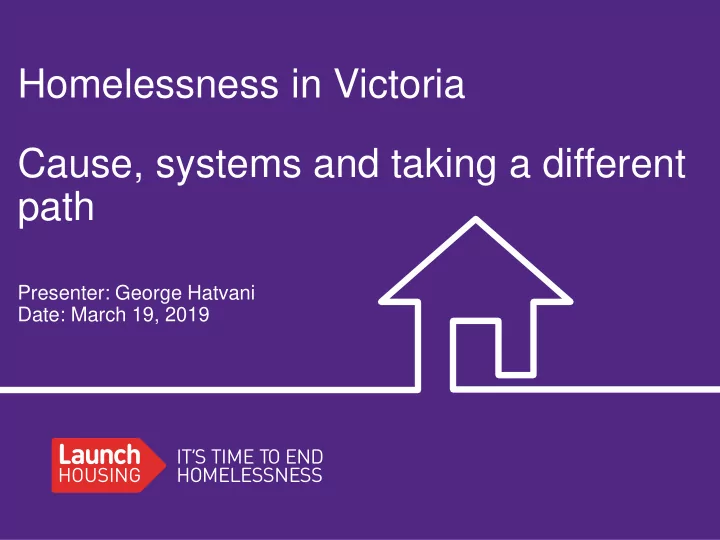

Homelessness in Victoria Cause, systems and taking a different path Presenter: George Hatvani Date: March 19, 2019
The Frame Micro to Macro and back again Observations on systems and their impact on homelessness, including some innovations coming your way
The Frame Individual Social
The Frame Time Past Future
The causes of homelessness Individual The why and the how of an event happening 1. Individual 2. Structural Social
Cause and the data we collect Specialist Homelessness Services Victoria 2017-18 Top 5 Reasons Top 5 Main reason 1. Domestic and family violence 47.4% 1. Domestic and family violence 38.3% 2. Financial difficulties 40% 2. Housing crisis 19.5% 3. Housing crisis 37% 3. Financial difficulties 10.3% 4. Housing affordability stress 24.5% 4. Inadequate or inappropriate dwelling 5. Inadequate or inappropriate dwelling conditions 8% conditions 23.4% 5. Housing affordability stress 5%
The causes of homelessness The why and the how of an event happening The relationship between housing and income But what else is going on?
The cause Individual The why and the how of an event happening 3. A Dynamic View Past Future Intersection between Happening in the ever the Individual and the moving present structures Social
The reality of causation There is more to cause Cause is much more complex and more deeply embedded in time • For the individual • For the structures And, in particular, in the interactions between them all…
System interactions Law including property law Housing system (especially low cost and exploitative private system) Employment (with income generation as a sub-set of economic system) Welfare system Welfare system Family violence service system Criminal justice system Mental health responses and as a service system Primary health responses and as a service system Aboriginal ‘responses’ and as a service system ‘ Care’ of children and as a service system Migration system Education and especially international students (2000's) <-------1788----1835 -----------------1900----------------1960----------------------2018------>
System interactions Social structures are made up of people These ‘agents’ serve as gatekeepers into and between systems, they perform roles in service of the system They/you/we are part of the culture of the system and act within its norms and rules 1. Where are they/you/we located within the constellation of services or systems that orbit the person experiencing homelessness? 2. Who are they/you/we to the person experiencing homelessness? 3. How much autonomy do they/you/we have? 4. How much impact upon the problem do they/you/we have?
Homelessness and time How many people are homeless right now?
Homelessness and time Number of Victorian’s Homeless: Census Data 2001 to 2016 30,000 25,000 24,817 22,306 20,000 18,154 15,000 17,410 10,000 5,000 0 2001 2006 2011 2016
Homelessness over time Another version of the dynamic view of homelessness
Ending homelessness How? Absolute Zero • Is this possible? Functional Zero • Most efficient service system possible where the time spent homeless is minimized • Reached when the number of people in the stock and inflow within a month is less than the average monthly placement rate into long-term housing • Needs to be sustained
Ending homelessness Functional zero – How and Hope 1. A clear and strategic goal 2. Collective Impact approach 3. By Name List 4. Command centre 5. Continuous Quality Improvement
Ending homelessness Functional Zero and what it means 1. Data integration 2. Cooperation 3. Innovation 4. Housing, housing, housing
Ending homelessness Functional Zero: challenges and what it is not 1. On its own it does not end homelessness – it is a method not an end in itself. 2. People experiencing homelessness 3. Communication and resources 4. Housing 5. Temporary accommodation 6. Political ideology/Public opinion
What it means to continue to be wrong Homelessness and mortality People experiencing homelessness • Are many times more likely to die than the general population, with significantly higher risk of mortality • Die younger (up to 30 years) These deaths are largely preventable if adequate housing and health supports are provided
Conclusion Individual Past Future Social
Questions? Discussion… Issues…
The data we collect Who is presenting for help? SHS 2017-18 Male 36% Female 64% How does this compare to ABS Data? ABS 2016 Male 58% Female 42% The Iceberg (ABS General Social Survey 2014) 15–34 35–64 65 years or Total years years over Sought assistance 33% 26% 41% 41% Did not seek assistance 67% 74% 59% 59%
Recommend
More recommend